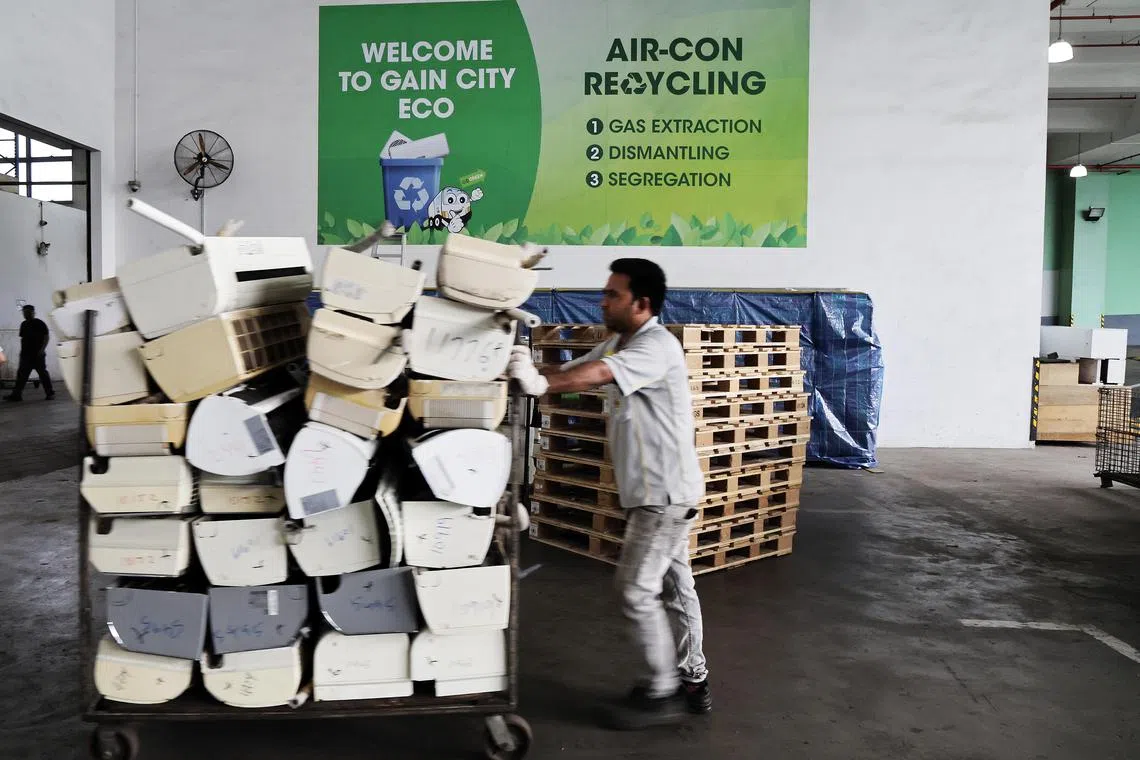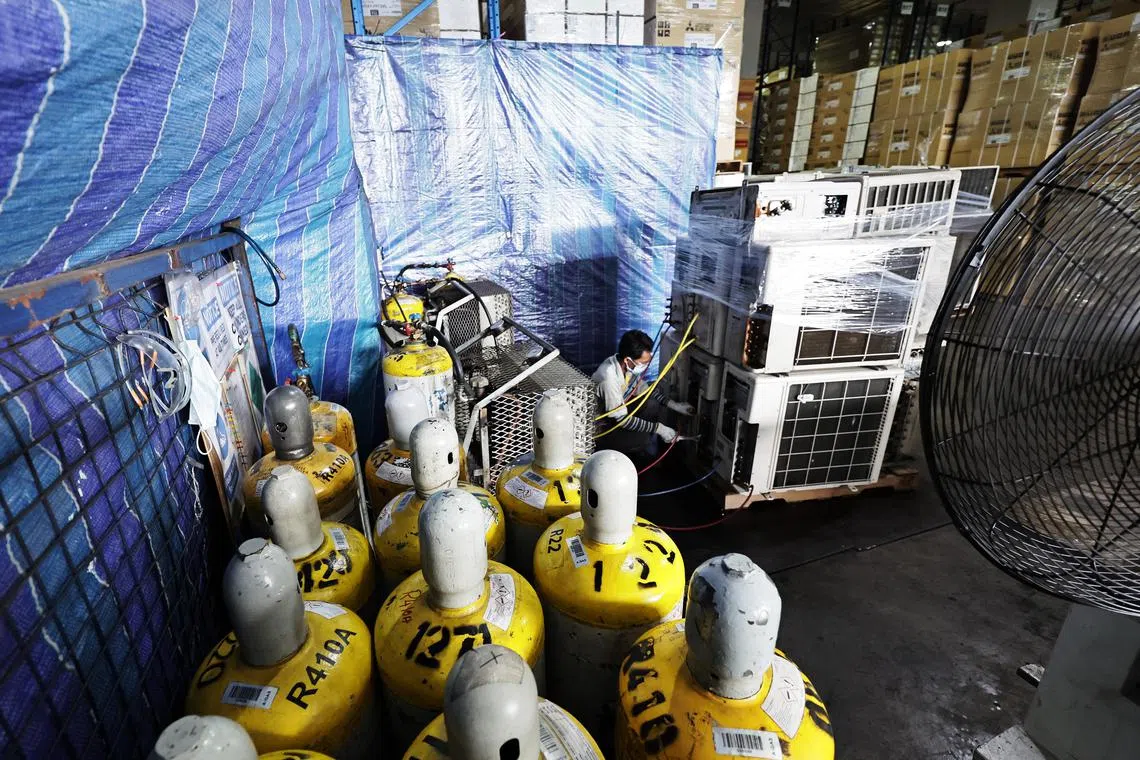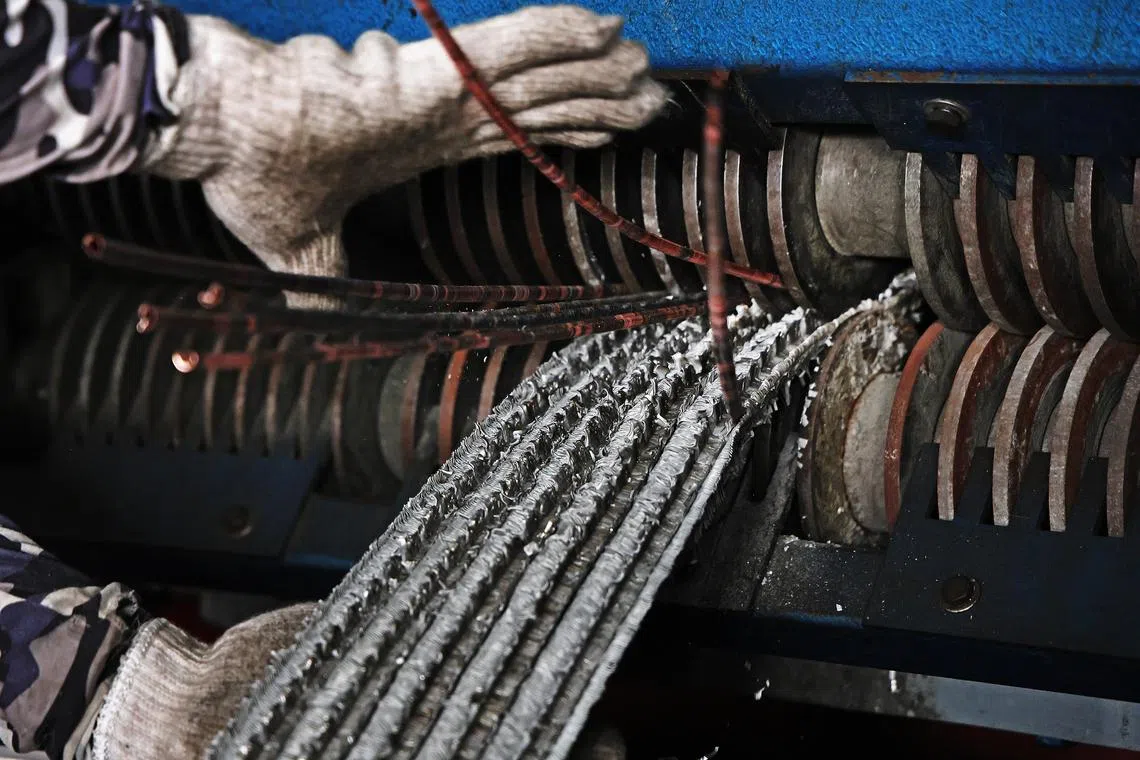Up to 90% of air-con units can be recycled, including greenhouse gas refrigerant
Sign up now: Get ST's newsletters delivered to your inbox

Recycling air-conditioners is crucial because they contain refrigerants such as hydrofluorocarbons, which can have a significant environmental impact if not properly recovered.
ST PHOTO: KELVIN CHING
Follow topic:
SINGAPORE – More than tens of thousands of air-conditioning units have been recycled and refurbished every month at Gain City’s Sungei Kadut Megastore under a scheme launched by the National Environment Agency (NEA) in 2021.
The Extended Producer Responsibility (EPR) is a regulated e-waste management system to ensure the proper collection and handling of e-waste and the extraction of valuable resources from e-waste.
Today, Gain City houses one of the two designated air-conditioner recycling facilities in Singapore. The other is Alba’s e-waste recycling facility in Tuas.
“Recycling air-conditioners is crucial because they contain refrigerants such as hydrofluorocarbons (HFCs), which can have a significant environmental impact if not properly recovered,” said a spokesperson for the Singapore Environment Council (SEC).
“HFCs are thousands of times more potent in causing global warming than carbon dioxide.”
SEC said air-conditioners also contain valuable materials like copper and aluminium that can be recovered, reducing the need for raw resource extraction and helping to ease pressure on Singapore’s limited landfill space.
According to NEA, Singapore generates about 60,000 tonnes of e-waste annually – equivalent to around 73 mobile phones discarded per person in Singapore – with only 6 per cent recycled.
“E-waste also contains small amounts of hazardous substances that may harm the environment and our health, if improperly disposed of,” the agency noted.
Attending a learning journey organised by the Public Hygiene Council at Gain City’s air-conditioner recycling facility on July 10, the media watched a demonstration of how an air-conditioning unit was recycled.
While Gain City was unable to provide the specific numbers of air-conditioning units recycled annually, it receives thousands of used units from consumers and businesses.
Before its megastore’s opening in 2015, Gain City had offered in-house air-conditioner recycling services on a much smaller scale and continued doing so until 2021 when, under the EPR, it established a proper recycling facility and tripled its manpower.
Gain City marketing director Candy Cao said up to 90 per cent of the units can be recycled, with a key part being the proper management of the refrigerant. Metals like gold, brass, aluminium and a large amount of copper can also be extracted and repurposed in refurbished sets, or sent for recycling.
When used air-conditioners are brought in, they are assessed to see if they can be refurbished and resold. Dismantled parts may be used for repairs.

The refrigerant is extracted from old units into cylinder tanks at the Gain City air-conditioner recycling facility.
ST PHOTO: KELVIN CHNG
Refurbished units are resold by wholesalers or through Gain City’s official Carousell account, often at prices up to 80 per cent lower than those of new units.
When units are taken apart, the refrigerant is extracted into cylinder tanks and sent to a local purification facility for treatment. The purified refrigerant is then exported to countries like India and Indonesia for reuse in new units.
The units are then stripped to their bare bones and sent for recycling. Printed circuit boards are taken apart manually and sent to specialised waste treatment centres for further processing.
Items such as fan blades, cooler blades, styrofoam and insulation piping cannot be recycled currently. Most of these are sent to waste treatment plants to be melted down.
Ms Cao shared that Gain City is currently working with Singapore Polytechnic’s Advanced Materials Technology Centre to repurpose some of these waste materials by breaking them down into smaller pieces to use as sustainable concrete.

Valuable materials like aluminium can be recovered from old air-conditioner units.
ST PHOTO: KELVIN CHNG
“We are also in talks with Mushroom World Academy, a non-profit organisation, to utilise cardboard boxes to grow mushrooms,” she added.
Customers buying a new air-conditioner from Gain City can trade in their old units to be recycled, and get some money to offset their new purchase, depending on the condition of the used units, said Ms Cao.
Charges may apply for standalone recycling, depending on the pickup location, quantity and dismantling requirements, especially for commercial units, she added.
Mr Chia Ket Fhung, owner of Ultimate Airconditioning Services, said he used to transport the dismantled units to sell to scrap metal collectors.
“We now have a one-stop solution – purchasing new units from Gain City and installing them, then dropping off the dismantled units for recycling at the same location,” he said.
Correction note: In an earlier version of the story, we said that thousands of air-conditioners are recycled yearly instead of tens of thousands recycled monthly. This has been corrected.

